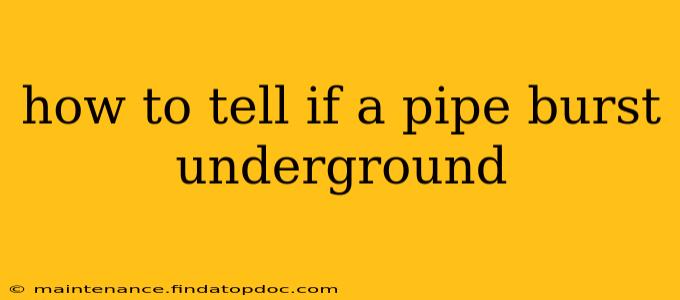A burst pipe underground can be a homeowner's nightmare, leading to significant water damage, property devaluation, and costly repairs. The challenge is that the damage often isn't immediately visible. This guide outlines how to identify the signs of an underground pipe burst, explores potential causes, and provides crucial steps for remediation.
Signs of a Burst Underground Pipe
Detecting a hidden pipe burst requires keen observation and a bit of detective work. Here are some key indicators:
-
Saturated or Soggy Ground: This is often the first visible sign. Look for unusually damp or muddy patches in your yard, especially near suspected pipe routes. A consistently wet area, even after periods of dry weather, warrants investigation.
-
Foundation Cracks or Settlement: If the water damage is extensive, it might affect your home's foundation. Look for cracks in your basement walls, floors, or exterior walls. Noticeable settling or unevenness of your foundation could also point to a serious underground leak.
-
Unusual Plant Growth: Interestingly, an unusually lush or vibrant patch of grass or other vegetation in your yard could signal a consistent source of water—a leaking pipe.
-
Increased Water Bills: A sudden and unexplained spike in your water bill, significantly higher than previous months, is a strong indication of a hidden leak somewhere on your property.
-
Slow Drains or Gurgling Pipes: While not directly related to an underground burst, these issues can be indicative of broader plumbing problems and might coincide with a deeper leak.
-
Musty Odor: If the burst pipe involves sewage or wastewater, you might detect a foul, musty odor emanating from the affected area.
-
Discolored Water: Occasionally, the water from your faucets might become discolored, possibly cloudy or brown, suggesting sediment or contamination from a ruptured pipe.
What Causes Underground Pipes to Burst?
Understanding the causes of underground pipe bursts helps in preventing future incidents. The most common culprits include:
-
Corrosion: Over time, pipes, particularly older metal ones, corrode and weaken, increasing their susceptibility to bursting under pressure.
-
Freezing Temperatures: Water expands when it freezes, exerting immense pressure on pipe walls. This is especially problematic in colder climates, where underground pipes are vulnerable to freezing.
-
Ground Shifting: Soil movement due to factors like tree roots, frost heave, or even seismic activity can put stress on underground pipes, leading to cracks or ruptures.
-
High Water Pressure: Excessive water pressure in your plumbing system can strain pipes, especially older ones, eventually leading to failure.
-
Clogs and Blockages: Blockages in pipes can increase pressure, potentially causing a weak point to burst.
How to Locate the Burst Pipe
Pinpointing the exact location of an underground burst is crucial for efficient repair. Consider these methods:
-
Visual Inspection: Start with a thorough visual inspection of your property, paying close attention to the signs mentioned above.
-
Professional Leak Detection: Plumbers often employ specialized equipment such as ground penetrating radar (GPR) or acoustic leak detection to precisely locate the source of a leak.
What to Do if You Suspect a Burst Pipe
If you suspect a burst underground pipe, take immediate action:
-
Turn off the main water supply: This is the most crucial step to prevent further water damage. Locate your main water shut-off valve (usually near the water meter) and turn it off.
-
Contact a qualified plumber: Don't attempt DIY repairs, as this can worsen the situation. A professional plumber will have the expertise and equipment to diagnose and repair the problem efficiently and safely.
-
Document the damage: Take photos and videos of the affected area, including any visible signs of water damage, to aid in insurance claims.
-
Contact your insurance company: Most homeowners' insurance policies cover water damage resulting from burst pipes. Notify your insurance company as soon as possible to initiate the claims process.
Addressing a burst underground pipe promptly and effectively is crucial to minimizing damage and associated costs. By recognizing the warning signs and taking swift action, you can protect your property and avoid significant headaches down the line.
